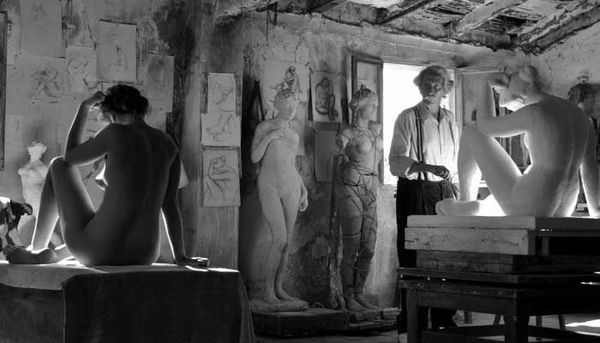 |
| Aida Folch and Jean Rochefort in The Artist And The Model |
Alongside Trueba was actress Aida Folch whose character Mercè is recruited by Claudia Cardinale's Léa Cros to become a muse for her husband, the artist Marc Cros, played by Jean Rochefort.
The film set in 1943 was co-written by long-time Buñuel collaborator Jean-Claude Carrière, who together with Günter Grass adapted his novel The Tin Drum for Volker Schlöndorff's Academy Award winning film of the same name. He is also the screenwriter for Atiq Rahimi's upcoming The Patience Stone.
I started our conversation off with a show-and-tell, beginning with a bird skull, resembling the one found in Trueba's film.
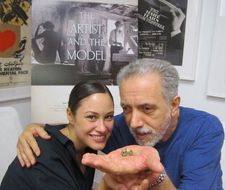 |
| Aida Folch and Fernando Trueba with the bird skull - 'This man in my movie is looking for forms, material things.' Photo: Anne-Katrin Titze |
Fernando Trueba: That's incredible. You found it the day you watched the film?
AKT: Yes, while gardening. You can imagine my surprise when I saw how you start the movie with a root, an empty bird's nest and a little skull just like this one. Can you talk about this beginning in nature with birds? The model herself has something of a temporarily captured bird.
FT: We decided from the beginning to start the story like that with Jean-Claude Carrière [who co-wrote the script with him]. This old man taking his daily walks, and he is always watching nature. He is looking for forms. He knows, he believes, that everything is in nature, even abstract art is in nature. Now that you are talking about birds, I love many lines of Picasso. I remember one that is very famous - "I don't look for, I find." And he said once: "Abstract art is for the birds. What's the drama?" He was talking about abstract art at the time, in the 40s or something like that.
This man in my movie is looking for forms, for material things. It was a beautiful way to start the movie. The things he found are related to birth, to death, to sex and eroticism. The small root has the form like a couple. You can see whatever you want, but it's like two bodies embracing. He is watching things and finding things. Why do you need to make anything, to make art, when everything is in nature? At the same time I think from the very beginning human beings had that need of re-creating. Not copying, that's a mechanical thing, but of re-creating life. I think that's what movies are about.
AKT: A few years ago, I saw a fascinating exhibition at the cinémathèque in Paris about Renoir father and son. Did you happen to catch it? Some of the lanscape scenes resemble paintings by Pierre-Auguste Renoir and you seem to be quoting from Jean Renoir's La Grande Illusion (1937).
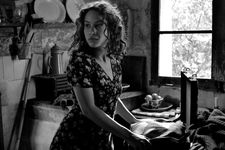 |
| Aida Folch as Mercè in The Artist And The Model. Folch: 'This is a very simple film, like a tree.' |
AKT: What about La Grande Illusion in your film? I am thinking of the scene with the Nazi [played by Götz Otto] who turns out to be an art professor from the University of Munich.
FT: That's good. I never thought of that. You know, with this professor I always thought of Henri-Pierre Roché, the author of Jules et Jim. I thought a lot of Count Kessler who was like the protector of Aristide Maillol. I never thought of La Grande Illusion and I love that. When people ask you about things that influence you - when you are making a movie, you are not thinking about other movies or trying to reproduce them, but everything you carry inside yourself is there.
AKT: I don't see links to other films as a bad thing. [See Guy Maddin's Séances project]
FT: And Renoir is very important in my life, and not just as a filmmaker. Renoir was crucial in my life as a human being. I would say my all-time favorite movie is Partie de Campagne (1936), that's a movie I've seen maybe fifty times, I can't count. Especially Renoir from the thirties. Toni (1935) is a movie that I love because it's so free, it's in nature, and it's very modern. When you watch Toni today, it looks like they are talking about emigrants today in Europe. So Renoir is always there.
AKT: Did you show Aida films to prepare for her role as an, how shall I put it, escape resistance artist's model in the 40s?
FT: We watched some films, yes. I asked her to watch The Wild Child for her character.
AKT: You are talking about Truffaut' s L'Enfant sauvage (1970)?
FT: The most Renoir-like Truffaut movie.
AKT: I can see it in the scenes when you are eating [turning to Aida]. You have to do a lot of ravenous, half-starved eating in the movie.
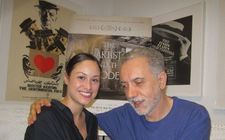 |
| Aida Folch with Fernando Trueba - 'Renoir is very important in my life' Photo: Anne-Katrin Titze |
AKT: There is a sequence where you swim near a waterfall which reminded me of the swimming scene in Ecstasy (1933) that made Hedy Lamarr famous.
FT: I'm glad you say that because I showed that scene, the very long long scene of Hedy Lamarr in nature to my Director of Photography [Daniel Vilar]. It's his first movie as DP. He has worked with me before as camera operator. He knows every modern movie, indie movies, but he is not familiar with classical cinema. So I told him to see movies from Renoir, Truffaut, Bresson. It was curious for me how he discovered these classical works. He was very interested to see Au Hasard Balthazar (1966) or Mouchette (1967) or Jules et Jim, or The Wild Child, what I was proposing for him to watch.
AKT: The scenes with the children seemed a bit like Fellini meets An American In Paris.
FT: At the same time, the only real cinephile wink in the movie is actually very secret. I never told that to anyone. When she crosses with the bicycle, that was a wink to Mario Camerini, who is a very forgotten Italian director but who had a sense of the moment. I don't know why but when I was shooting I was thinking of Mario Camerini in a very Thirties or Forties moment.
AKT: Explain the name of your protagonist, Marc Cros played by Jean Rochefort. Mark Cross is the name on my bag, [I show them the second object I brought for this interview], and it is the brand Grace Kelly's character carries in Hitchcock's Rear Window. Voyeurism hidden in a Freudian bag or an entirely different Cross to carry?
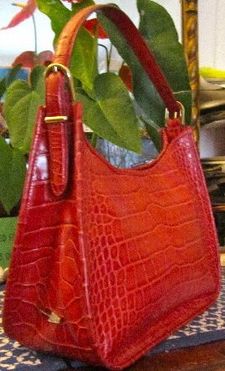 |
| Mark Cross bag; Aida Folch: 'The skull and the bag you brought are incredible.' Photo: Anne-Katrin Titze |
AKT: In Antonioni's Identification Of A Woman (1982) the male character, Niccolo, who is also a filmmaker, says the line, "I want to have the kind of relationship with a woman that you have with nature." Is this the way your protagonist feels, too?
FT: No. But I like the line.
AKT: Speak about your sound design. Lots of crickets, bird sounds, nature. You use music very sparsely at the end.
FT: There was no music. Just Mahler at the end and maybe 30 seconds of Duke Ellington's Caravan, that's all. I told Pierre Gamet, the sound engineer, "you are the composer in that movie." I worked with him since my first movie. We are very good friends. For me he is the greatest sound engineer. For this movie I wanted pure sound. We live in a world today of sound design and sound recreation and we have lost the purity of sound. The beauty of the real sound. In most movies today the sound isn't real. Sometimes it's great, but I wanted to listen to even the silence. I wanted people to realize that sound is not just noise effects one after another. I wanted to go to the fountain, the original thing, no?
AKT: A little boy is confused why doctors and artists can see naked women and asks about priests, why they can't see naked women. Are you hinting at more sinister topics about this priest and the boys? I couldn't tell.
FT: It's an innocent question. It's the kind of question a boy would have had at the time. There was the question why only the artist can see the body. It's a beautiful and innocent kind of thing to ask.
AKT: Aida, how did you feel about the gender roles depicted in this movie? Did you have questions about her modeling for the famous old man? Did you maybe feel you wanted her to be an artist herself, switching roles, instead of serving food?
AF: I think the body of the woman was very popular in the arts in the past and now too because it's very beautiful. I think it is an act that is very generous, to present your body to make a work of art. With the boys and the men it's the same. Michelangelo and the others. At the time of the film there were a lot of sculptors who made the female form. It's a very interesting experience because before shooting the film, I stayed with a real sculptor and it was a very rich experience. I think it is very difficult work. The skull and the bag you brought are incredible!
FT: Aristide Maillol is the origin of the movie. I was always fascinated by this man who consecrated 100 per cent of his work to the woman's body. An artist can do many different things, but for Maillol that was the universe.AKT: You sum it up in the film - the female body and olive oil are proof of God.
FT: That was for me at the origin of the movie, that for me was fascinating, you know. An artist who is on this quest for beauty but he has to limit his landscape, his universe to that. Everything is in nature, everything is in the female body.
The Artist and the Model, begins in a timeless nature. The Café de la Paix on a rural market square in occupied France artfully sets the tone in Fernando Trueba's celluloid dream.
The film opens in New York on August 2. It will be released in cinemas across the UK on September 13.





















